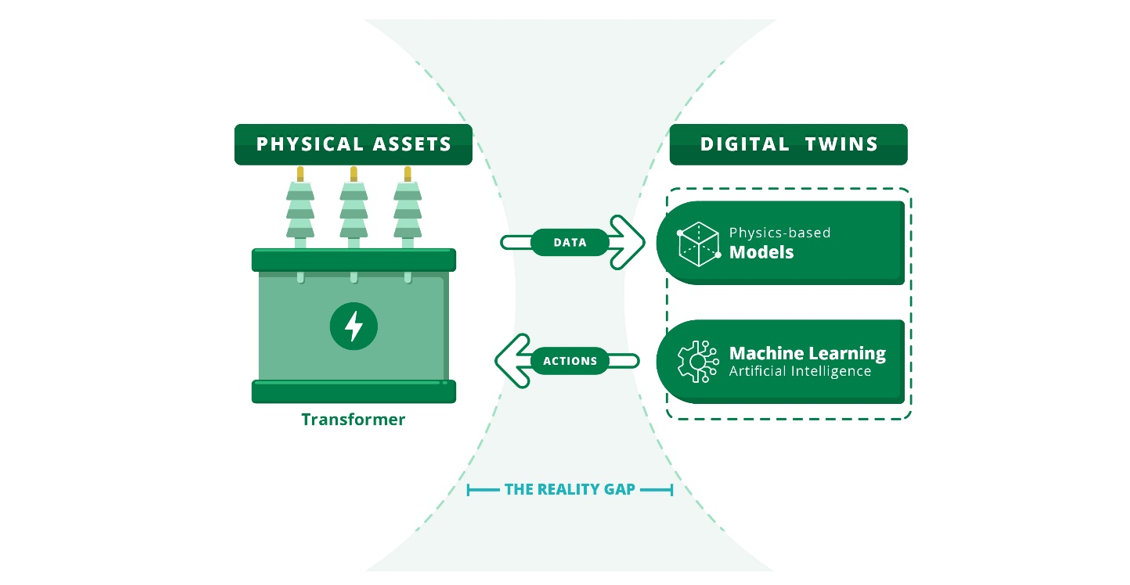Transforming Transformers: The Power of Digitalisation
 |
 |
In today's rapidly evolving energy landscape, the concepts of digitalisation and digital twin have emerged as powerful tools to drive innovation and optimise the operation of complex systems. As we explore the interactions between these concepts, we discover their significance in various aspects of power transformer operations, including predictive maintenance and performance optimisation. Moreover, we examine the role of digital twins in enhancing visibility, facilitating proactive decision-making, and mitigating risks. By leveraging these technologies, the power industry can achieve greater efficiency, reliability, and sustainability, ultimately shaping a resilient energy future.
Accelerating the energy transition: the three Ds approach
The three Ds of the energy transition refer to three key elements driving the transformation of the global energy system.
These elements are decarbonisation, decentralisation, and digitalisation.
- Decarbonisation refers to reducing or eliminating carbon dioxide (CO2) and other greenhouse gas emissions from the energy sector. It involves shifting away from fossil fuels and increasing the share of renewable energy sources.
- Decentralisation shifts away from centralised energy generation and distribution, where power is predominantly produced in large power plants and transmitted over long distances to consumers. Instead, the focus is on a more distributed energy system characterised by smaller-scale and localised energy generation.
- Digitalisation, also known as the digital transformation of the energy sector, involves the application of digital technologies, data analytics, and advanced communication systems to optimise energy generation, distribution, and consumption. It encompasses various technological advancements, such as smart grids, Internet of Things (IoT) devices, artificial intelligence (AI), machine learning, and data analytics. Digitalisation plays a crucial role in optimising energy use, improving grid reliability, and integrating renewable energy.
Understanding Digitisation, Digitalisation, and Digital twin concepts
"Digitalisation" and "digitisation" are often used interchangeably but have slightly different meanings.
Digitisation refers to the process of converting analog data into digital form. For example, in the context of power transformers, digitisation may refer to converting analog data from sensors or instruments into digital signals that can be processed and analysed by a computer or other digital device.
On the other hand, digitalisation refers to the broader process of using digital technologies to transform business processes, operations, and customer experiences. For example, with power transformers, digitalisation may involve digitising data from sensors and instruments and using advanced analytics, machine learning, and other digital technologies to analyse that data and make predictions about the transformer's performance.
In short, digitisation is the first step in digitalisation, which involves using digital technologies to improve performance, efficiency, and outcomes.
Digitalisation and digital twin are closely intertwined concepts that are part of the ongoing technological advancements in various industries, including the energy sector.
A digital twin is a virtual representation or a digital replica of a physical asset, system, or process (Figure 1). It is a digital counterpart that mimics the behaviour and characteristics of its physical counterpart in real-time or near-real-time. Digital twins are created using various data sources, including sensors, design information, and historical inspection data, to capture and model the physical asset's behaviour and performance. The digital twin creates a feedback loop where the real-time data collected from the physical system is fed into the digital twin for analysis and prediction. The results and insights obtained from these models can then be used to update and improve the digital twin, ensuring their accuracy and relevance over time.

Figure 1 - The digital twin concept (from CIGRE JWG A2/D2.65)
As digitalisation advances, it provides the necessary infrastructure and technologies to collect vast amounts of data from physical assets and systems.
Digital twins can be created in the energy sector for various components, such as power plants, transmission networks, and strategic assets like power transformers. These digital twins enable operators and engineers to monitor and analyse the performance of these assets, identify potential issues or inefficiencies, simulate different scenarios, and optimise operations.
Harnessing the power of digitalisation and digital twin for power transformers
Digitalisation and digital twin concepts are applied to power transformers to enhance their monitoring, maintenance, and overall performance.
- Digitalisation allows for real-time monitoring of power transformers by integrating sensors that collect data on parameters such as temperature, load level, dissolved gas in oil, bushing tap current, vibrations, and partial discharges. By continuously monitoring the transformer's condition, potential issues or abnormalities can be detected early on, allowing for timely maintenance and preventing costly failures.
- Digital twins can be created for power transformers, representing their physical counterparts in a virtual environment. The digital twin can simulate different operating scenarios, monitor performance, and predict future behaviour. Data analytics such as physics-based models, AI algorithms, hybrid models, and statistical tools help identify optimisation opportunities, evaluate the impact of operational changes such as dynamic overloading, and test maintenance strategies without affecting the physical transformer. Prognostics involve forecasting the future performance and health of the transformer, estimating the remaining useful life, and assessing the probability of failure.
When implementing digitalisation in power transformers, it is important to prioritise regulatory compliance and safety requirements. Special attention must be given to cybersecurity measures to ensure the protection of the system from potential cyber-attacks that may jeopardize its safety and reliability.
Digitalisation and digital twin concepts are closely intertwined with various activities conducted by CIGRE in the domain of power transformers (Study Committee A2). These concepts find applications in several areas, including modelling, condition assessment, maintenance, material performance, ageing, sensors, and diagnostics. CIGRE has dedicated working groups focusing on exploring and advancing these areas. Here are some examples:
- Transformers Thermal Modelling: One of the areas where digitalisation and digital twin concepts are applied is in the dynamic thermal modelling of transformers. CIGRE's Working Group A2.60 is actively studying this field, aiming to develop improved models and methodologies for accurately predicting and managing the thermal behaviour of transformers.
- Transformer Digital Twin: The concept of the digital twin for transformers is being explored by the Joint Working Group (JWG) A2/D2.65. This group is focused on understanding the potential and future perspectives of digital twin technology for transformers, investigating its benefits, challenges, and possible implementation strategies.
- Another area where digitalisation plays a crucial role is in interpreting critical monitoring data for transformers. CIGRE's JWG A2/D1.67 is working on developing guidelines and best practices for effectively interpreting the data collected through online dissolved gas monitoring systems. These guidelines aid in assessing the condition and health of transformers based on the dissolved gas analysis (DGA).
Overall, digitalisation and digital twin concepts have significant relevance and impact on various aspects of power transformers within CIGRE's activities. These concepts enable advancements in thermal modelling, provide insights into transformer health through condition assessment and diagnostics, guide maintenance practices, explore the potential of digital twin technology, and facilitate the interpretation of critical monitoring data. By actively researching and developing guidelines in these areas, CIGRE contributes to the continued improvement and optimisation of the industry's power transformer operation and maintenance practices.
